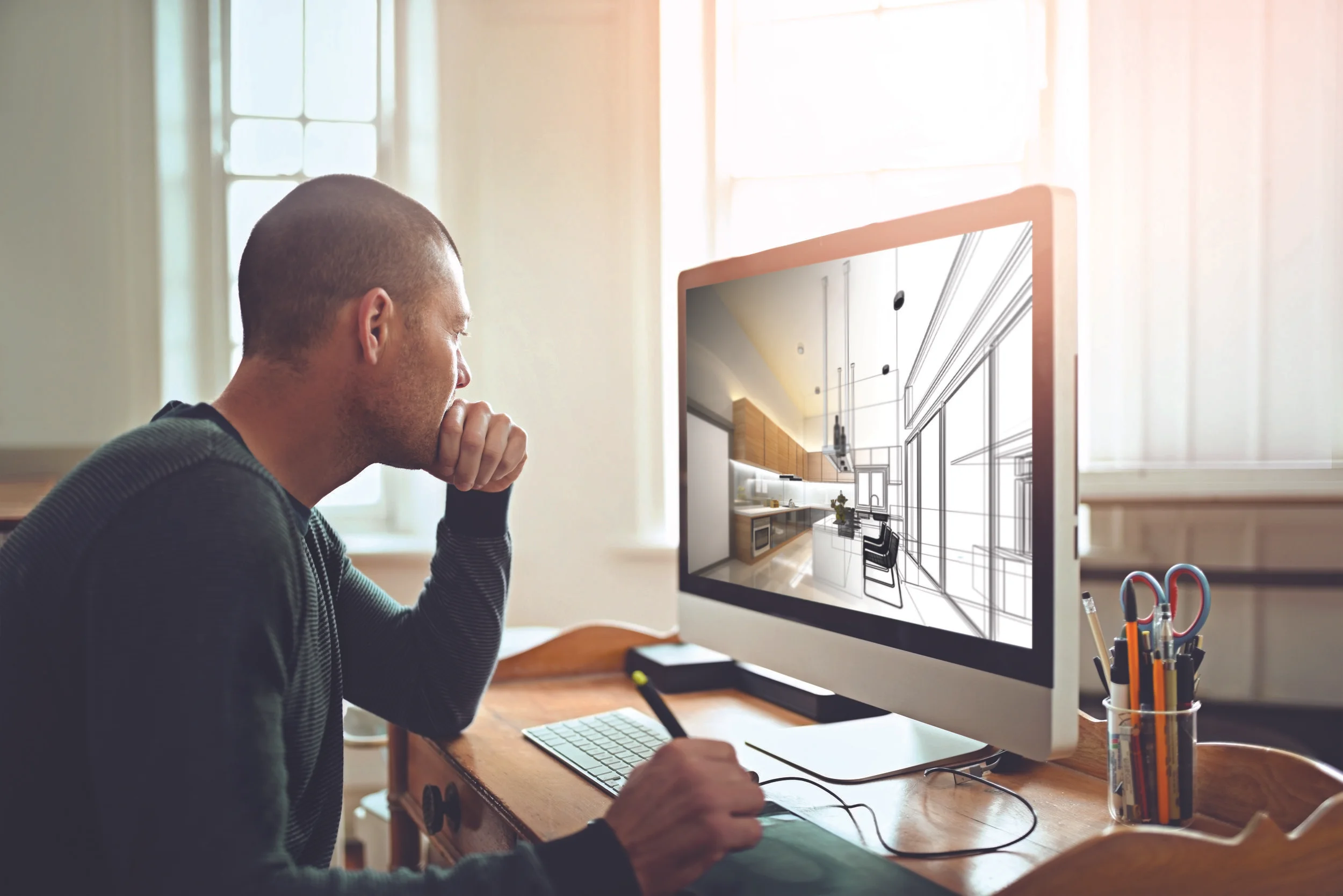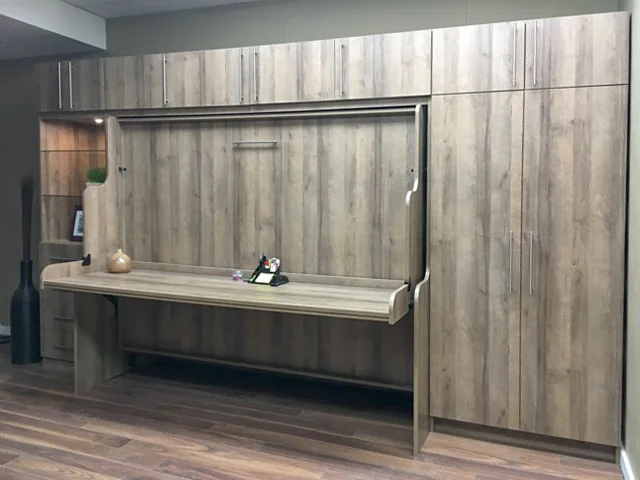Uniboard’s Secret Weapon: Design 360,
A Complete Digital Solution for Design Software
Interiors and furniture are designed, refined and sold on screens. It’s the first place most people will ever lay eyes on a material as they search for the perfect finish for their kitchen or the next hotel brand launch.
If your material files happen to look so good it that they make designers’ concepts and renderings look incredible, the design community will take notice.
Just ask Uniboard.
Uniboard Canada is leading producer of decorative TFL panels in North America, with a long reputation for pushing boundaries. Beginning in the mid 1990s with Uniboard driving, TFL began its journey from a commodity panel for cabinet interiors to a durable and convincingly realistic alternative to solid woods and veneers. In 2016 Uniboard was the first North American TFL manufacturer to launch a synchronized a synchronized embossed-in-register (EIR) texture. High-fidelity printed designs are now “synchronized” with carefully engineered textures, perfectly aligning every knot and tick to create wood surfaces that are increasingly used as a responsible go-to alternative for high-use applications, and where design consistency and cost efficiency are important to the project.
Uniboard worked directly with all major design software suppliers to ensure the compatability of their image files.
Many of these woodgrain designs are so realistic, woodworking industry veterans are hard-pressed to tell them from solid wood or veneer … even when they’re holding panels in their hands.
Which brings us back to the beginning of our story. How would someone who’s designing or browsing on a screen ever see how incredible these materials look in real life?
Uniboard’s answer is Design 360: Ultra high-resolution scans of the company’s finished TFL panels, available in files compatible with all of today’s top design software.
“We’ve made sure our files work on every platform – 20/20, Sketchup, Revvit, CabinetVision, Vectorworks, Autodesk – by working directly with the design software companies,” says Ariane Bouchard, Marketing Specialist for Uniboard. “In many cases our designs and textures are already in the program’s catalog. And for users of SketchUp, for example, we’ve created a library in 3D Warehouse, so our designs are accessible to everyone.
“In addition to high resolution files, we provide animated GIFs, which are short animations using a light effect to show the gloss level and the texture of each finish.”
Uniboard’s approach to digitally cataloging their decorative panels
sets a new standard for the industry in three ways:
- The scans can be up to 900 dpi – incredibly high resolution for close-up fidelity and realistic detail
- The entire 4x8’ panels are scanned with the woodgrain character in place, so designers can position the panels to control the nature of each face in their project
- The panels’ textures are also scanned – not just the color and contrast – for accurate rendering behavior in
applications that allow control over lighting sources
By scanning their finished panels, instead of attempting to approximate a finished-panel look using files supplied by décor paper printers, Design 360 has given Uniboard a true advantage. No matter how many hours a software genius puts into creating a virtual panel surface, it still looks more virtual than real. The Design 360 files, on the other hand, help designers create digital mockups that look like photos of an actual room or piece of furniture.
And who doesn’t want their designs to look as realistic as possible?
“This all started as a pretty small project,” says Don Raymond, Vice President of Marketing and Sales for Uniboard. “Our industry has traditionally shown only small parts of their panel designs online. We were getting so many requests to show the entire panel so they could see the full character of the design. Then they asked for files in high resolution. Then they asked for them in specific formats compatible with their design software.
“So we decided, ‘If we’re going to do this, we need to do it right.’ Let’s give them exactly the tools they are asking for.”
The entire process began over two years ago. Scanning the panels themselves took nine months.
“We knew people would find this useful, but we didn’t expect it to be such a huge success,” says Bouchard. “We’re hearing from architects and designers that our files are the best quality they’ve ever seen.”
Design 360 Files Make Renderings Far More Realistic
K34, Dorato Natural
K37 Endgrain
K36 Soho
K30 Spectra
Uniboard has long been a leader in North American TFL design. They were the first major producer to master synchronized textures, and have just introduced a high-resolution library of decorative panel scans compatible with all major design software products.
Hiddenbed Makes Lifelong Furniture with
Uniboard TFL
Space is at a premium. Durability is critical. Quality is a given. And design matters.
Mike Solmundson and Robert Enns have created a thriving business – Hiddenbed Canada Direct – by successfully addressing the above challenges.
Hiddenbed is a trademarked international technology for creating beds that fold into desks to save space, a perfect solution for guest rooms in condos, senior housing, student housing and hotels. The system allows regional licensees to use different panel products to create the final product, giving them the freedom to create individualized designs for their markets and customer demographics.
“A big part of our customer base are retirees who are now downsizing into smaller homes and condos, says Solmundson. “They want their office or craft space in the spare room, but they also want a place for the grandkids to sleep when they visit. It’s a bit like creating a second spare room.”
“These are people who aren’t as worried about cost as they are about durable functionality,” says Enns, “and they aren’t interested in compromising on design – they want something that’s stylish and looks good. This is why we build our Hiddenbeds with TFL panels from Uniboard.”
“We sell this as life-long furniture. Unlike a couch that might last 10 years, the Hiddenbed is designed to last much longer. The durability of the TFL finishes from Uniboard are outstanding. They literally take years and years of abuse without showing any wear.”
Hiddenbed Canada Direct has also sold Hiddenbeds for use in college housing, where space is also at a premium. And the daily use in those settings truly puts them to the test.
“There’s a college in Manitoba where our beds get daily use. We inspected them after two years, and there were absolutely no issues,” says Solmundson.
Enns and Solmundson have been working with Uniboard panels since 2010 because they like the company’s designs, support, and the easy machinability of the panels. With matching PVC edgebanding, the ¾-inch-thick finished panels are more than durable enough for high-use commercial applications.
Uniboard’s latest generation of panels with high-definition woodgrain patterns were introduced in 2014, launching Hiddenbed’s products into a new realm of quality and realism.
“The rustic finishes, with crosshatch texture aligned with the design, are quite popular, as are the more refined woodgrains,” says Solmundson. “These are a pretty stunning upgrade from the older standard finishes in TFL. It’s amazing how far these surfaces have come.”
Above, a comfy bedroom; below, a productive office ... all in the same space!
The nightstand becomes office storage once the bed is folded away, below..






